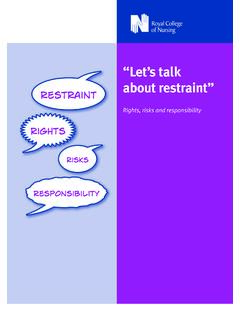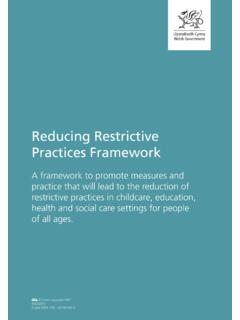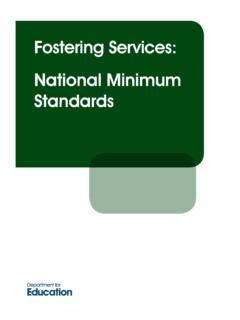Transcription of Restraint Reduction Network Training Standards 2021
1 Ethical Training Standards to protect human rights and minimise restrictive practices Restraint Reduction Network (RRN). Training Standards First edition James Ridley Sarah Leitch British Library Cataloguing in Publication Data A CIP record for this book is available from the British Library BILD Publications First published 2019. Version published July 2021. BILD Publications is the imprint of: British Institute of Learning Disabilities Birmingham Research Park 97 Vincent Drive Edgbaston Birmingham B15 2SQ. Telephone: 0121 415 6960. E-mail: Website: No part of this book may be reproduced without prior permission from the publisher, except for the quotation of brief passages for review, teaching or reference purposes, when an acknowledgement of the source must be given.
2 ISBN 978 1 905218 44 8. Printed in the UK by Page Bros (Norwich) Ltd Copy editing by Helen Fairlie Design by Sarah McCall 2 Restraint Reduction Network Training Standards Contents Foreword 7. Introduction 11. Background 11. Why are the Restraint Reduction Network Training Standards required? 12. Aims of the Training Standards 14. Who are the Training Standards for? 15. How have the Training Standards been developed? 17. How to use these Training Standards 18. Reviewing and updating the Training Standards 19. A rights based framework for Training 21. A human rights approach to restrictive interventions 22. The relationship between legislative frameworks involved in restrictive interventions 25.
3 Being person centred to respect and protect human rights 27. Contents 3. Training Standards 31. Section 1 Standards supporting pre-delivery processes 33. Standard Training needs analysis 37. Standard Developing and authorising the content of the Training curriculum 39. Standard Independent risk assessment of techniques 43. Standard Committing to the Reduction of the use of all restrictive interventions and practices 46. Standard Involving people with lived experience 47. Standard Agreeing delivery plans 48. Standard Providing accessible information 50. Standard Responding to concerns and complaints 51. 4 Restraint Reduction Network Training Standards Section 2 Standards supporting curriculum content 53.
4 Standard Placing the curriculum within a rights based framework 55. Standard Duty of candour and duty of care 56. Standard Attitudes and attributions 58. Standard Considered decision making 59. Standard Primary and preventative strategies 60. Standard Teaching secondary strategies 62. Standard Teaching non- restrictive tertiary strategies 63. Standard Teaching restrictive tertiary strategies 64. Standard Use of mechanical Restraint 69. Standard Factors that contribute to risk and elevated risk 71. Standard Emergency procedures 72. Standard Identifying the range of restrictive practices 75. Standard Use of data to inform minimisation 76. Standard Post-incident support, review and learning 77.
5 Standard Trauma informed care and support 79. Standard Restraint Reduction theory 80. Contents 5. Section 3 Standards supporting post-delivery processes 81. Standard Competence, assessment and feedback 82. Standard Record keeping 84. Standard Reporting concerns 86. Standard Evaluation 86. Standard Quality assurance 87. Standard Refresher Training 88. Section 4 Trainer Standards 91. Standard Quality assurance 93. Standard Training competence 94. Standard Professional competence 94. Standard Delivering relevant content 97. Standard Insurance 98. Standard Safety 98. Standard Professional development 100. Appendices 101. Glossary 171. References 177. Acknowledgements 185.
6 6 Restraint Reduction Network Training Standards Foreword You may not know us, but we want to tell you about something very personal that shattered our lives and changed our family forever. This is a photo of our son Seni with his grandmother. Everything you need to know about him is here in this beautiful picture. He was our baby and a gentle giant. He hated bullying and was always looking out for the less able and vulnerable people in society. Seni was just 23 years old an IT graduate when he died in hospital on 3. September 2010. He died because of prolonged Restraint , when he was held down by 11 police offcers while he was a patient in a mental health hospital.
7 Seni had never had any mental health issues before, but over that bank holiday weekend in 2010 he seemed agitated and his behaviour became odd. We took him to A&E and, after an assessment, we were told to take him to Bethlem Royal Hospital. We took him there, to what we thought would be the best place for him to get help. Foreword 7. Seni agreed to stay overnight at the hospital as a voluntary patient. We were asked to leave him at the end of visiting hours, and we did so reluct- antly. Shortly afterwards, he became agitated when he was stopped from leaving the hospital because he wanted to come home. The hospital staff sectioned' him and called the police who came and agreed to take Seni to a seclusion room in the hospital.
8 He was co-operative until he stopped at the threshold of the seclusion room. As soon as he stopped, the police offcers pushed him inside and forced him face down to the foor. The police offcers held Seni face down, shackled his hands with two sets of handcuffs and put his legs in two sets of restraints. They held him down like that over a period of some 45 minutes altogether, in a Restraint they knew was dangerous, until he went limp. And even then, instead of treating him as a medical emergency, they simply walked away: they believed he was faking it! They left our son on the foor of a locked room, all but dead. All of this happened in the presence of hospital staff including nurses and a doctor who stood by and looked on, unable or unwilling to intervene.
9 Seni never regained consciousness and died four days later. That is how we lost our beloved son. At the inquest into his death, the jury found Seni died as a result of excessive, disproportionate and unreasonable Restraint and force. To this day, we struggle to comprehend that our son died as he did, simply because those who were responsible for his care police offcers and medical staff alike failed in their duty to treat him with the respect that he deserved as a human being. 8 Restraint Reduction Network Training Standards In a signed statement after these events, one doctor described how the offcers treated our son: I felt like it wasn't a human being that they were trying to restrain it was like trying to contain an animal after they had tied him up with the straps it seemed like when a hunter has tied the animal it was an uneasy feeling that I had that it was not a human being that they were restraining'.
10 That is how he was seen and treated at that point: as an animal, rather than a petrifed young man, terrifed at the prospect of being put in a padded seclusion room. We don't want anyone else to go through this. We have been fghting for over eight years to get answers and justice for Seni. Now, through initiatives in his name such as Seni's Law, a parliamentary bill with cross party support designed to open up the system to greater transparency and accountability to stop the disproportionate use of force and Restraint we feel that our son may not have died in vain. If we can make sure this never happens to anyone else, that would be an amazing legacy for Seni. That is why we are really pleased to see the publication of these new Standards , but this must be just the beginning.





